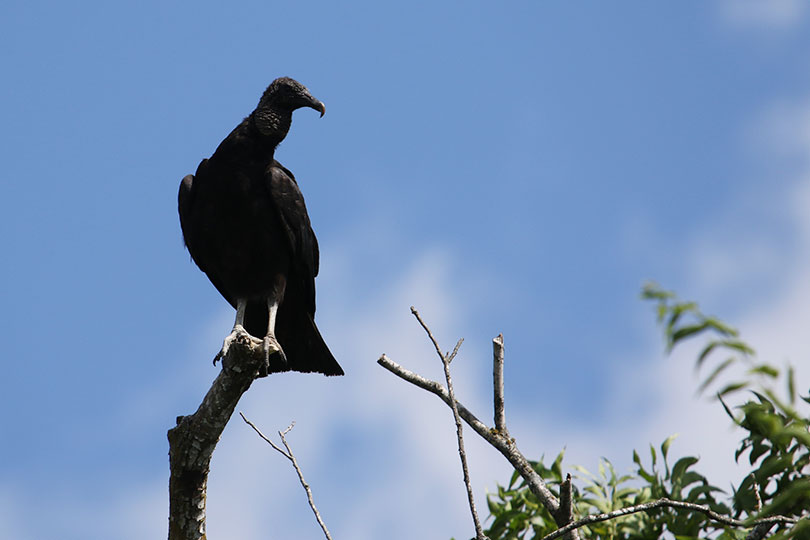By Julie Tomascik
Editor
It’s what ranchers don’t want to see—black vultures circling a pasture, especially when livestock are being born. But it’s becoming a more common occurrence as black vultures expand their range northward due to warmer weather and man-made roosting and nesting structures.
“There are two types of vultures in Texas—the turkey vulture and the black vulture,” Mike Bodenchuk, director of Texas Wildlife Services (TWS), said. “Turkey vultures find their food by their sense of smell, but black vultures find their food through eyesight.”
Black vultures can key in on areas where livestock are having their young.
While they provide an essential ecological service by cleaning up carcasses, they also can kill young livestock.
The problem has only worsened over the years. The growth in numbers and range has led to increased black vulture predation on newborn livestock.
“Twenty, thirty years ago, black vultures were largely found in Texas south of I-10, but they’ve expanded their range considerably up into the South Panhandle and other northern parts of Texas,” Bodenchuk said.
Black vultures have a feeding range of up to 30 miles per day, meaning they will travel far from their nesting area to find a carcass or small animal.
“So, we have a lot more birds. We have them over a lot larger part of the state, and they’re very aggressive in terms of competing with each other for food,” Bodenchuk said. “There’s much more livestock loss today than there was 20 or 30 years ago.”
Black vultures, however, are protected by the Migratory Bird Treaty Act, and livestock producers are limited in how they can keep the birds from attacking their livestock.
To help Texas ranchers who are losing livestock to black vultures, the U.S. Fish and Wildlife Service granted a permit to the Texas Wildlife Damage Management Association (TWDMA) for black vulture management for the lethal removal of up to 750 vultures. TWDMA is a member of the cooperative TWS.
Ranchers can apply for sub-permits through TWS, which would allow them to remove up to five black vultures each during the year.
The depredation sub-permits allow for the lethal removal of a limited number of vultures to reinforce the non-injurious harassment.
“Landowners who want to use non-injurious methods do not need to participate in this program,” Bodenchuk said. “The program is only for those who might need to remove a small number of vultures to reinforce the non-lethal hazing.”
Those methods include auditory and visual dispersal methods like lasers and propane cannons.
“Landowners and ranchers can go out there and chase birds away from their livestock. They can bring their livestock closer to the house, where they can keep an eye on them giving birth,” Bodenchuk said. “Black vultures can be deterred from small pastures with things like effigies, artificial vultures or dead vultures. So that will haze them out of an area for a while. You can use noisemakers, dogs—whatever doesn’t injure the bird.”
He noted TWS also recommends ranchers hang the dead vultures in a nearby tree because vultures don’t like to come near a dead vulture.
“Using a vulture that’s shot as an effigy or using an artificial effigy—a body that looks like a vulture with wings and a head, hung upside down in trees around the pasture—can help keep vultures out of those areas,” Bodenchuk said. “We recommend one effigy to about five acres. So, you couldn’t do this in a large pasture, but it you have a confined area where livestock are giving birth, the effigies are useful as a way of hazing vultures out of the area.”
For more information on black vulture depredation management, call TWS at one of the district offices:
Canyon: 806-651-2880
College Station: 979-599-5070
Corpus Christi: 361-299-1176
Ft. Stockton: 432-360-1122
Ft. Worth: 817-978-3146
Kerrville: 830-896-6535
San Angelo: 325-655-6101
Uvalde: 830-278-4464
Click here for more information on vulture damage management.


I’m in Blanco County and would like to be apart of this program.
Hi! To participate, you would need to contact your TWS District Office. The list is included in the story above.
Can we apply in Wharton county and if so how
Hi! You would need to contact your TWS District Office. The list is in the story above.
I am in Wilson County. Will we be able to get some permits.
Hi! You would need to contact your TWS District Office. The list is in the story above.
I would like to aquire permit for removal. I am in clay county
I live in Webb County and would like to know where to call and apply for permit
Hi! You would need to contact your TWS District Office. The list is in the story above.
I live in San Augustine County. Would I be eligible?
Hi! You would need to contact your TWS District Office. The list is in the story above.
I am in mason county which office do I ask for information .
You can contact the office that’s closest to your location, but all offices should be able to help any landowner get registered for a permit, if there are any left.